Amano American Sanders American 12 User manual

Drum Sander
American 12
Operator’s Manual

3
EN
2
EN
***This product is intended for commercial use only***
WARNING!
The Products sold with this Manual contain or may contain chemicals that are known to certain governments (such as the State of
California, as identied in its Proposition 65 Regulatory Warning Law) to cause cancer, birth defects or other reproductive harm. In
certain locations (including the State of California) purchasers of these Products that place them in service at an employment job site
or a publicly accessible space are required by regulation to make certain notices, warnings or disclosures regarding the chemicals that
are or may be contained in the Products at or about such work sites. It is the purchaser’s responsibility to know the content of, and
to comply with, any laws and regulations relating to the use of these Products in such environments. The Manufacturer disclaims any
responsibility to advise purchasers of any specic requirements that may be applicable to the use of the Products in such environments.
In this Operation Manual you will find three statements that you must read and observe to ensure safe operation of this
machine.
DANGER means: Severe bodily injury or death can occur to you or other personnel if the DANGER statements
found on this machine or in this Operation Manual are ignored or are not adhered to. Read and observe
all DANGER statements found in this Operation Manual and on your machine.
WARNING means: Injury can occur to you or to other personnel if the WARNING statements found on your
machine or in the Operation Manual are ignored or are not adhered to. Read and observe all WARNING
statements found in this Operation Manual and on your machine.
CAUTION means: Damage can occur to the machine or to other property if the CAUTION statements found
on your machine or in this Operation Manual are ignored or are not adhered to. Read and observe all
CAUTION statements found in this Operation Manual and on your machine.
Operator Safety Instructions
DANGER: Failure to read the Owner’s Manual prior to operating or servicing your American Sanders machine could result in injury to
you or to other personnel; damage to the machine or to other property could occur as well. You must have training in the
operation of this machine before using it. If you or your operator(s) cannot read English, have this manual explained fully
before attempting to operate this machine.
DANGER: A. Sanding/nishing wood oors can create an explosive or combustible environment. Do not operate this machine around
solvents, thinners, alcohol, fuels, oor nishes, wood dust or any other ammable materials. Cigarette lighters, pilot lights,
electrical sparks and all other sources of ignition should be extinguished or avoided. Keep work area well ventilated.
B. Dust generated from sanding wood oors can spontaneously ignite or explode. Promptly dispose of any sanding dust in
a metal container clear of any combustibles. Do not dispose in a re.
DANGER: A. Electrocution could occur if the machine is being serviced while the machine is connected to a power source. Disconnect
the power supply before servicing.
B. Electrocution or re could occur if the machine is being operated with a damaged power cord. Keep the power cord clear
of the pad. Always lift the cord over the machine. Do not move the machine by the power cord.
C.Shock hazard. Do not use the machine if it has been rained on or sprayed with water.
DANGER: To avoid injury keep hands, feet, and loose clothing away from all moving parts on the machine. Disconnect the power cord
before replacing the pad, changing the abrasive, or when servicing. Do not operate the machine unless all guards are in
place. Never leave the machine unattended while connected to a power source.
WARNING: Injury can occur if protective clothing or equipment is not used while sanding. Always wear safety goggles, protective
clothing, and dust mask while sanding.
WARNING: This sander is not to be used on pressure treated wood. Some pressure treated woods contain arsenic and sanding
pressure treated wood produces hazardous dust. Inhaling hazardous dust from pressure treated wood can cause serious
injury or death. Sanding pressure treated wood decks or uneven surfaces can damage the sander which is not covered
under warranty or damage waiver.
WARNING: Any alterations or modications of this machine could result in damage to the machine or injury to the operator or other
bystanders. Alterations or modications not authorized by the manufacturer voids any and all warranties and liabilities.
WARNING: Risk of explosion. Floor sanding can result in an explosive mixture of ne dust and air. Use oor sanding machine only in a
well-ventilated area free from any ame or match.
SECTION II - Parts and Service Manual
Handle Assy (Models 07108A, 07109A, 07204A, 07108C) .................. 36
Handle Assy (Model 07001A, 07108B)................................................. 38
Handle Assy (Model 07120A). .............................................................. 40
Motor Assy (Model 07001A, 07108B). .................................................. 42
Motor Assy (Models 07108A, 07109A, 07204A, 07108C) .................... 43
Motor Assy (Model 07120A) ................................................................. 44
Drum Assy ............................................................................................ 45
Dust Control Assy ................................................................................. 46
Base Assy ............................................................................................. 48
Base Assy (Models 07044C, 07049C).................................................. 50
Belt Guard Assy (Models 07108A, 07109A, 07204A, 07108C) ............ 52
Belt Guard (Model 07001A, 07108B) ................................................... 53
Belt Guard (Model 07120A) .................................................................. 54
Accessories .......................................................................................... 55
Wiring Diagrams ................................................................................... 56
Warranty ............................................................................................... 58
Contents
Operator Safety Instructions ...............................2
Introduction and Machine Specications ............6
230V Electrical Connection Instructions
.............
7
How to Transport the Machine............................8
Machine Set-Up ..................................................9
How to Operate the Machine ............................10
Sanding Cuts and Sandpaper ..........................13
Sander Adjustment Procedures ........................13
Routine Maintenance........................................15
Troubleshooting ................................................16
Chatter-Wave Prevention .................................17
General Power Tool Safety Warnings
WARNING: Read all safety warnings and instructions. Failure to follow warnings and instructions may result in electric
shock, re and or serious injury.
Save all warnings and instructions for future use.
The term "power tool" in the warnings refers to your main-operated (corded) power tool or battery operated (cordless) power tool.
1) Work area safety
a) Keep work area clean and well lit. Clutter or dark areas invite accidents .
b)
Power tools create sparks which may ignite the dust or fumes.
c) Distractions can cause you to lose control.
2) Electrical safety
a) Power tool plugs must match the outlet. Never modify the plug in any way. Do not use any adapter plugs with
earthed (grounded) power tools. Unmodied plugs and matching outlets will reduce risk of electric shock .
b) There is an
increased risk of electric shock if your body is earthed or grounded .
c) Do not expose power tools to rain or wet conditions. Water entering a power tool will increase the risk of electric shock.
d)
heat, oil, sharp edges or moving parts. Damaged or entangled cords increase the risk of electric shock.
e) Use of cord suitable for outdoor
use reduces the risk of electric shock .
READ THIS BOOK
This book has important information for the use and safe operation of this machine. Failure to read this book prior to operating
or attempting any service or maintenance procedure to your American Sanders machine could result in injury to you or to other
personnel; damage to the machine or to other property could occur as well. You must have training in the operation of this machine
before using it. If your operator(s) cannot read this manual, have it explained fully before attempting to operate this machine.
All directions given in this book are as seen from the operator’s position at the rear of the machine.

45
EN EN
f)
interrupter (GFCI ) protected supply. Use of a RCD or GFCI reduces the risk of electric shock .
3) Personal safety
a) Stay alert, watch what you are doing and use common sense when operating a power tool. Do not use a power tool
A moment of inattention while operating
power tools may result in serious personal injury.
b} Protective equipment such as dust mask, non-skid
safety shoes, hard hat, or hearing protection used for appropriate conditions will reduce personal injury.
c)
pack, picking up, or carrying the tool. Carrying power tools with your nger on the switch or energizing power tools that
have the switch on invites accidents .
d) A wrench or key left attached to a rotating part
of the power tool may result in personal injury.
e) This enables better control of the power tool in
unexpected situations .
f) Dress properly. Do not wear loose clothing or jewelry. Keep your hair, clothing and gloves away from moving parts.
Loose clothes, jewelry, or long hair can be caught in moving parts.
g) If devices are provided for the connection of dust extraction and collection facilities, ensure these are connected and
properly used. Use of dust collection can reduce dust related hazards. It is recommendation that the tool always be supplied
via a residual current device with a rated residual current of 30mA or less.
4) Power tool use and care
a) Do not force the power tool. Use the correct power tool for your application. The correct power tool will do the job better
and safer at the rate for which it was designed .
b) Any power tool that cannot be controlled with the
switch is dangerous and must be repaired .
c)
adjustments, changing accessories or storing power tools. Such preventative safety measures reduce the risk of starting
the power tool accidently.
d) Store idle power tools out of the reach of children and do not allow persons unfamiliar with the power tool or these
instructions to operate the power tool. Power tools are dangerous in the hands of untrained users.
e)
Many accidents are
caused by poorly maintained power tools .
f) Keep cutting tools sharp and clean. Properly maintained cutting tools with sharp cutting edges are less likely to bind and
are easier to control.
g)
Use of the power tool for operations dierent from those intended could
result in a hazardous situation.
5) Service
a) This will ensure that
the safety of the power tool is maintained . If the supply cord is damaged, it must be replaced by the manufacturer, its service
agent or similarly qualied persons in order to avoid a hazard.
Safety Warnings For Sanding Operations
1. This power tool is intended to function as a sander. Read all safety warnings, instructions and specications provided with
this power tool. Failure to follow all instructions listed below may result in electric shock, re, or personal injury.
2. Operations such as grinding, wire brushing, polishing or cutting-o, are not recommended to be performed with this power tool.
Operations for which the tool was not designed may create a hazard and cause personal injury.
3. Do not use accessories which are not specically designed and recommended by the tool manufacturer. Just because the
accessory can be attached to your power tool, it does not assure safe operation .
4. The rated speed of the accessory must be at least equal to the maximum speed marked on the power tool. Accessories
running faster than their rated speed can break and y apart .
5. The outside diameter and thickness of your accessory must be within the capacity rating of your power tool. Incorrectly sized
accessories cannot be adequately guard or controlled.
6. The arbor size of wheels, anges, backing pads or any other accessory must t the spindle of the power tool. Accessories
with arbor holes that do not match the mounting hardware of the power tool will run out of balance, vibrate excessively and
may cause loss of control.
7. Do not use damaged accessory. Before each use inspect the accessory such as abrasive wheel for chips or cracks, backing
pad for cracks, tear or excess wear, wire brush for loose or cracked wires . If power tool or accessory is dropped, inspect
for damage or install an undamaged accessory. After inspecting or installing an accessory, position yourself or bystanders
away from the plane of the rotating accessory and run the power tool at maximum no-load speed for one minute . Damaged
accessories will normally break apart during this time .
8. Wear personal protective equipment. Depending on application, use face shield, safety goggles or safety glasses. As
appropriate, wear dust mask, hearing protectors, gloves and workshop apron capable of stopping ying debris generated by
various operations. The eye protection must be capable of stopping ying debris generated by various operations . The dust
mask or respirator must be capable of ltering particles generated by your operations. Prolonged exposure to high intensity
noise may cause hearing loss.
9. Keep bystanders a safe distance away from work area. Anyone entering the work area must wear personal protective
equipment. Fragments of work piece or a broken accessory mayy away and cause injury beyond immediate area of
operation .
10. Hold power tool by gripping insulated surfaces (handle) only, when performing an operation where the cutting accessory may
contact hidden wiring or its own cord. Cutting accessory contacting a "live" wire may make exposed metal parts of the power
tool "live" and shock the operator.
11. Position the cord clear of the spinning accessory. If you loose control, the cord may be cut or snagged and your arm or hand
may be pulled into the spinning accessory.
12. Never lay the power tool down until the accessory has come to a complete stop. The spinning accessory may grab the
surface and pull the power tool out of your control.
13. Do not run the power tool while carrying it at your side. Accidental contact with the spinning accessory could snag your
clothing, pulling the accessory into your body.
14. Regularly clean the power tools air vents. The motor's fan will draw the dust inside the housing and excessive accumulation
may cause electrical hazards.
15. Do not operate the power tool near ammable materials. Sparks could ignite these materials.
16. Do not use excessively oversized sanding disc paper. Follow manufacturer's recommendations when selecting sanding paper.
Larger sanding paper extending beyond the sanding pad presents a laceration hazard and may cause snagging, tearing of the
disc or kickback.
17. Risk of explosion. Floor sanding can result in an explosive mixture of ne dust and air. Use oor sanding machine only in a
well-ventilated area free from any ame or match.
Kickback is a sudden reaction to a pinched or snagged rotating wheel, backing pad, brush or any other accessory. Pinching or
snagging causes rapid stalling of the rotating backing pad which in turn causes uncontrolled power tool to be forced in the opposite
direction of the backing pad's rotation at the point of the binding.
For example, if an abrasive wheel is snagged or pinched by the work piece, the edge of the wheel that is entering into the pinch
point can dig into the surface of the material causing the wheel to climb out or kick out. The wheel may either jump toward or away
from the operator, depending on direction of the wheel's movement at the point of pinching. Abrasive wheels may also break under
these conditions.
Kickback is the result of power tool misuse and incorrect operating procedures or conditions and can be avoided by taking proper
precautions as given below.
1. Maintain a rm grip on the power tool and position your body and arms to allow you to resist kickback forces . Always use
auxiliary handles, if provided for maximum control over kickback or torque reactions during start up. The operator can control
torque reactions or kickback forces, if proper precautions are taken.
2. Never place your hand near the rotating accessory. Accessory may kickback over your hand.
3. Do not position your body in the area where power tool will move if kickback occurs. Kickback will propel the tool in the
direction opposite to the wheel's movement at the point of the snagging.
4. Use special care when working corners, sharp edges etc. Avoid bouncing and snagging the accessory. Corners, sharp edges
or bouncing have a tendency to snag the rotating accessory and cause loss of control or kickback.
Additional Rules For Safe Operation
1. Empty the dust bag or dust collection receiver frequently. Do not leave residue in dust bag or dust collection receiver
unattended . Always empty in a non-combustible metal container. Sanding wood or varnish produces dust that can self ignite
and cause injury or damage. Follow this precaution for storage.
2. Set all exposed nails. Sweep loose abrasive away from work area. Do not strike metal pipes, ect., with sanding paper.
Striking metal or abrasive particles with sanding paper produces sparks that could ignite the sanding dust which can cause
injury or damage.
3. Do not operate a partially assemble power tool. Keep all adjustments within manufacturer's specications . Keep all fasteners
tight. Operating a partially assembled power tool could result in injury to the operator or bystander and could cause damage to
the equipment or surroundings .
4. Do not attempt to change the sanding paper while the power tool is running. The sanding pad can snag clothing and cause
injury to limbs and moving sanding paper can cause abrasions.
5. The power tool should only be used on an electrical system (mains) that is rated for the electrical requirements of the power
tool as shown on the nameplate. Use only on an earthing (grounded) system. Do not service the power tool if it is energized
or connected to an electrical circuit. Improper use could cause re or electric shock.

67
EN EN
Introduction Electrical Connection Instructions
CAUTION: Your equipment may be inappropriate on some installations. Some softer woods used in ooring cannot support the
pressure created by hard wheels. Always consult with the ooring manufacturer on the proper installation, preparation,
and nishing of their product. Determine suitability of your equipment in preparing the product.
Tool Storage Tray Leveling Adjustment
Sanding Pres. Adjust
Motor Starter / Protector
Operating Controls
CAUTION: This machine will operate only on AC fre-
quency and on electrical voltage shown on
the equipment nameplate. Make sure you
havethe correctfrequencyand voltagebefore
connecting the power cord to an outlet. See
the example in gure 1.
This machine must be connected to an electrical source with an
earthing conductor in order to protect the operator from electric
shock. This machine has an approved power cord with three
conductors as well as a plug with three terminals. Connect the
plug to a matching receptacle.
DANGER: Electrocution could occur if the machine is
exposed to water or rain. Keep the machine
in a dry building.
DANGER: Electrocution could occur if machine is not
connected to an electrical source with an
earthing conductor. To prevent possible
electric shock, use an electrical cord with an
earthing conductor and connect it to a match-
ingelectrical source. Formaximum protection
against electrical shock, use a circuit that is
protected by a ground fault circuit interrupter.
Consult your electrical contractor.
DANGER: Electrocution could occur if the machine is
used with a damaged plug or power cord. If
the cords or plugs are worn or damaged in
any way, have them replaced by an authorized
service person or electrician.
Extension Cords
Use only an approved three-pronged extension cord with two main
conductors and one earthing conductor. This machine is equipped
with a power cord. When greater range is needed follow the table
below to determine cable gauge of additional footage. Refer to
the chart to the right for extension cord information.
If motor appears to labor or takes a considerable longer time to
come up to speed reduce sanding pressure.
Feet/Wire Guage (Stranded Copper)
208 6
230 10 8
Use Voltage
Booster
Figure 1
07108A / 07204A / 07108C 07109A 07120A
MODEL
Electrical Requirements ~208-240V 60 Hz ~220-240V 50 Hz ~220-240V 50 Hz -230V6 0 Hz 3Ø
Amperage 15.7 11.8 11.8 24
Sound Emisson{Lpm) 83.0 dB(A) 79.4 dB(A) 79.4d B(A) 83.0 dB(A)
Contact Wheel Rate(rpm) 2000/240 1670/200 1670/2000 2000/240
Abrasive Rate 3800/4560 ft/ min 970/1160 m/min 970/1160 m/min 3800/4560 ft/ min
Abrasive Sheet Size 280 CFM 970/1160 m/min 970/1160 m/min 3800/4560 ft/ min
Fan Flow Rate 12" x261/8" 305mm x 664mm 305mm x 664mm 12" X 26 1/8"
Motor 4 Hp Continuous 2.2 kW Continuous 2.2 kW Continuous 10 Hp
Overload Protection Magnetic Circuit Breaker Magnetic Circuit Breaker 13 A Fuse Magnetic Circuit Breaker
Operating Controls Adjustable Lever/Grip Adjustable Lever/Grip Adjustable Lever/Grip Adjustable Lever/Grip
Leveling Controls Externally Adjustable Externally Adjustable Externally Adjustable Externally Adjustable
Electrical Cable 100' 10-3 SJO with H05VVF3G4.0 H07RNF3G1.5 mm N/A
L6-20P Plug AU3-20P Plug with UK1-13P Plug
Operating Wheels 80 Durometer 80 Durometer 80 Durometer 80 Durometer
Clear Urethane Clear Urethane Clear Urethane Clear Urethane
Weight 240 lbs. 204 lbs. 92.7 kg 256 lbs
Dimensions 40½X 15X 36 3/4 40½X 15X 36 3/4 103cmx 38cmx 93cm 40½X 15X 36 3/4

8 9
EN EN
Machine Transportation
WARNING: The machine is heavy. Remove the motor
from the machine before transporting. Get
help loading the machine and motor.
To transport the machine, follow this procedure:
1. Make sure the power cable is disconnected from the electrical
outlet.
2. Disconnect the handle plug connection. See gure 1.
3. Remove the belt cover.
4. Remove the fan belt.
5. Loosen the motor bolt. Using the ¾" wrench, turn the motor bolt
counterclockwise. See gure 2.
6. Slide the motor forward.
7. Remove the drive belt.
8. Remove the motor from the chassis.
To re-assemble the machine after transporting, follow this
procedure:
1. Reposition motor on chassis.
2. Install the drum belt. Slide the motor back until adequate tension
is achieved in belt.
CAUTION: To prevent damage to the oor surface,
make sure the drive belt is tight.
3. Resecure the motor to the chassis.
4. Install the fan belt.
5.
Install the belt cover.
6. Reconnect the handle plug.
Figure 1
Figure 2
To set-up your machine follow this procedure:
1. Familiarize yourself with the machine and read all danger,
warning and caution statements. Make sure all operators of
this machine have read this Owner's Manual. If they cannot
read English, have the manual explained fully before allowing
anyone to operate the sander.
2. Locate the power supply. The receptacle should be
compatible with the plug. The receptacle must be grounded
and must be fused (30 amp) to avoid an electrical hazard.
3. Clip the dust bag to the elbow. Cross the strings on the dust
bag and draw tight over the are on the elbow. Wrap the
string around the elbow and secure.
4. Wind the power cord through the cable arm. Keep the power
cord out of path of equipment.
How To Install The Abrasive
To install the abrasive, follow this procedure:
1. Prepare abrasive with template supplied.
2. Place backing of abrasive on the template. The template is
marked "This Side Up." Make sure the marked side of the
template is facing up.
3. Cut the abrasive to the exact lenght of the template.
4. Align one edge of the abrasive with a notch in the template.
5. Fold the other end of the abrasive over the end of the template
and crease.
6. Repeat steps 4 and 5 for remaining notch.
7. Lift the drum cover.
8. Put the smooth side of the abrasive against the sanding drum.
9. Put one end of the abrasive against the sanding drum slot (1).
See gure 3.
10. Turn the drum one revolution. Put the other end of the
abrasive in the drum slot (2).
See gure 3.
WARNING: Disconnect power before
changing abrasive.
11. Tighten the abrasive.
To tighten the abrasive, follow this procedure:
1. The end wrenches are given with the machine.
Put a wrench around the nut at each end of the
durm (1).
See gure 4.
2. Make sure the at sides of the nuts
are parallel with the drum slot.
3. Turn the wrenches the opposite rotation
until the abrasive is tight against the drum (2).
See gure 4.
12. Remove the end wrenches.
13. Close the cover.
NOTE: When using #4 or 4½ grit abrasive,
remove the large grains from the folded
ends. To remove the grains, rub the
folded ends together.
Figure 3
Figure 4
This manual suits for next models
7
Table of contents
Languages:
Other Amano Sander manuals
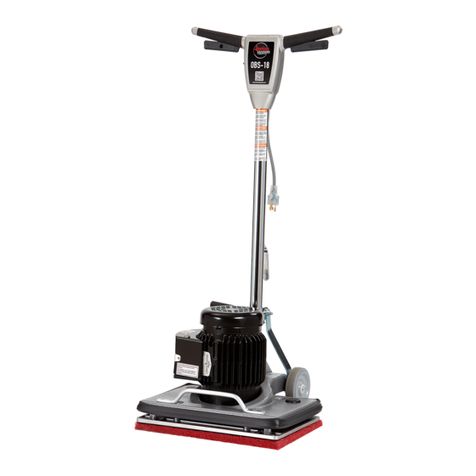
Amano
Amano American Sanders OSB-18 User manual
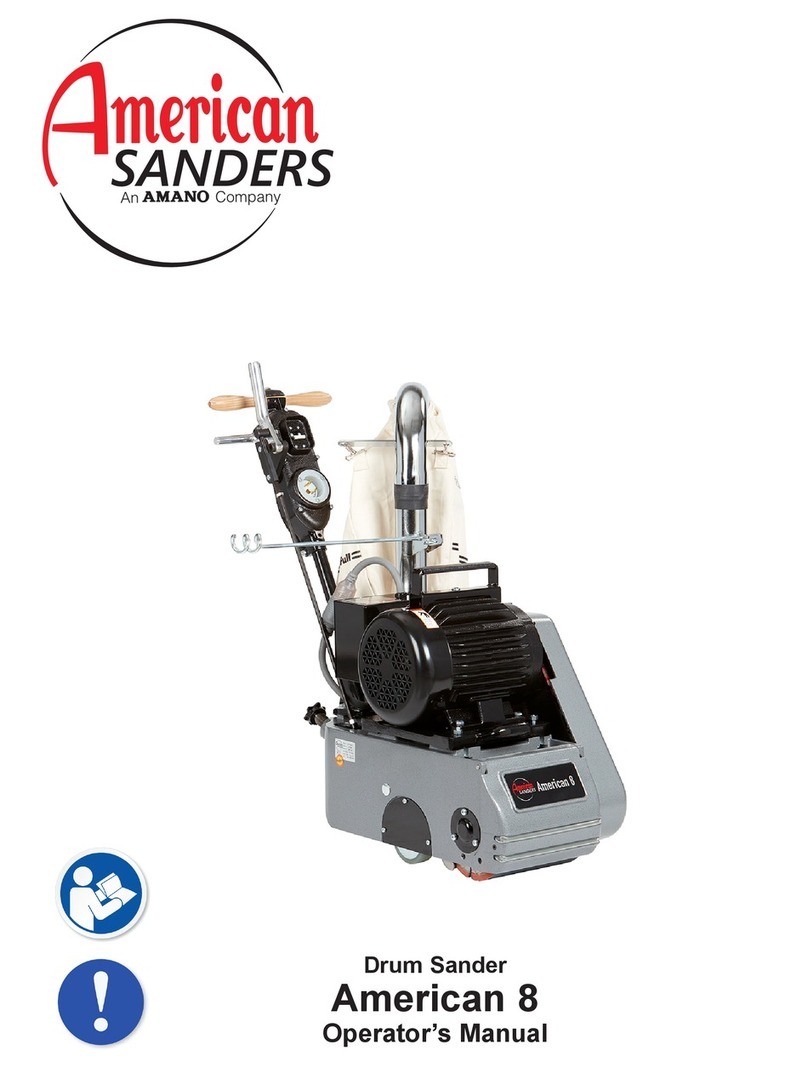
Amano
Amano American Sanders American 8 User manual

Amano
Amano American Sanders 3DS User manual

Amano
Amano American Sanders OBS-18DC User manual
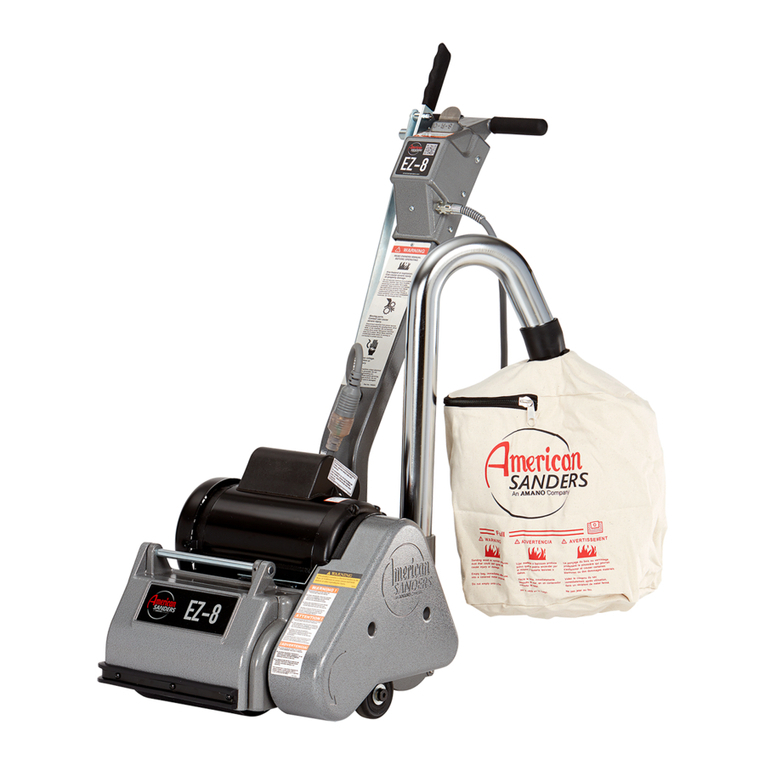
Amano
Amano American SANDERS EZ-8 User manual
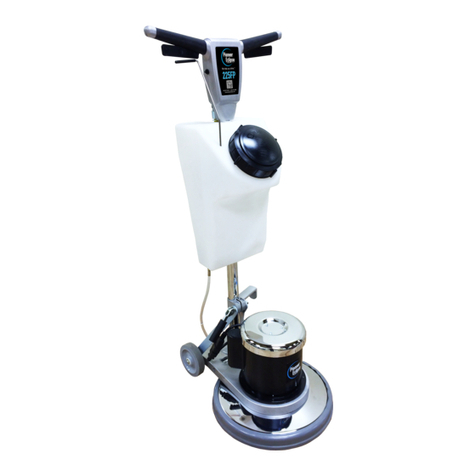
Amano
Amano Pioneer Eclipse 225FP16TR User manual
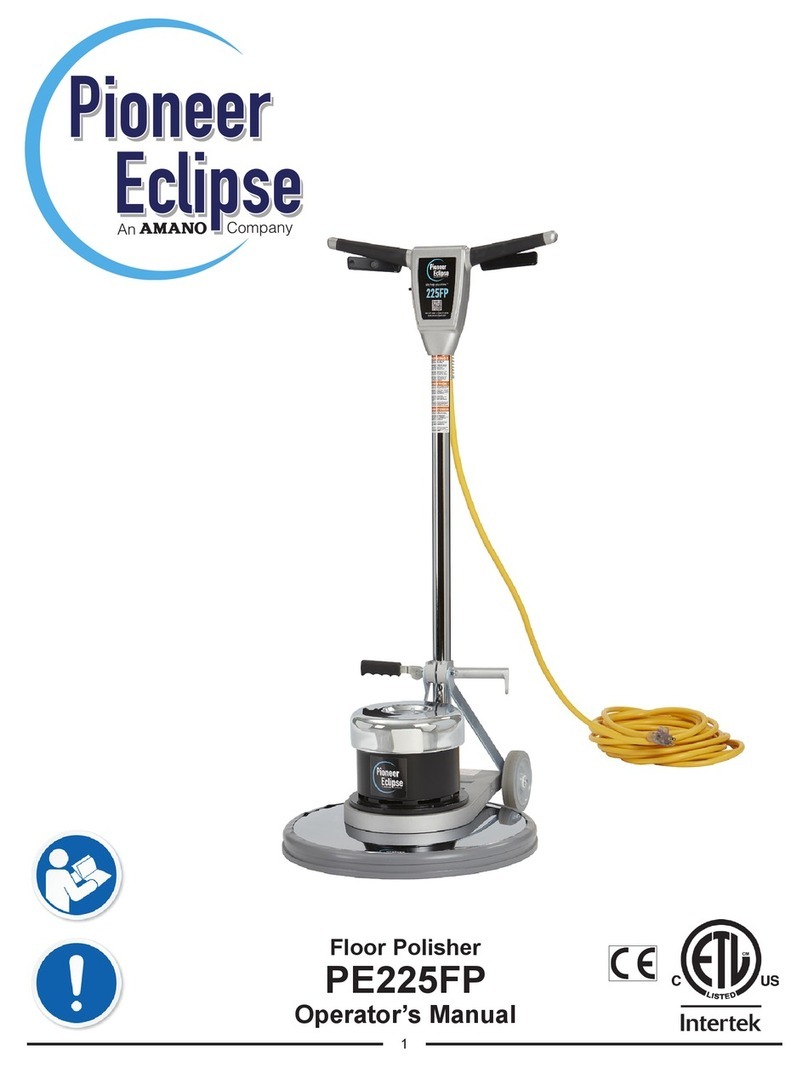
Amano
Amano Pioneer Eclipse PE225FP User manual

Amano
Amano American SANDERS FloorCrafter User manual

Amano
Amano American SANDERS EZ Sand - HDTR User manual
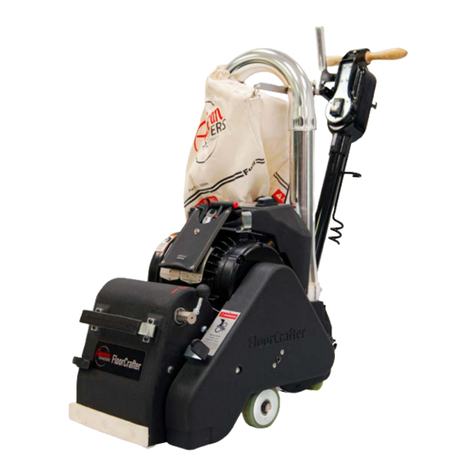
Amano
Amano American SANDERS FloorCrafter User manual



















